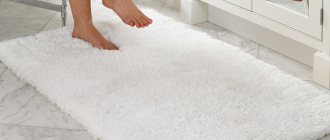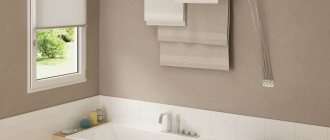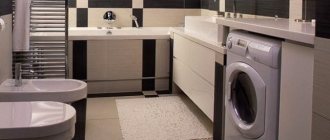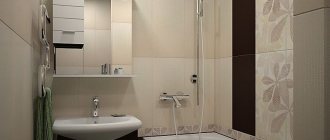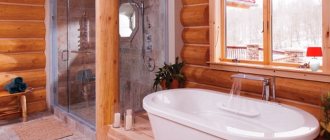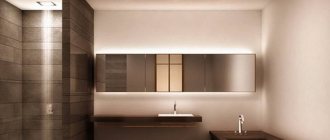According to statistics, a large number of accidents occur in the bathroom. A person here must always be attentive. The source of danger is slippery floors and damp wiring. You could fall and get electrocuted. The walls are corroded by fungus, we must constantly think about good detergents and cleaners, about cleaning and disinfection. It can be downright annoying. In order to calmly go into your bathroom, wash your face, brush your teeth, wash your hands, it would be good to get rid of nervous tension.
Bathroom
Modifications of wall heaters for the bathroom
Today, a heated floor is often used to heat a bathroom. The solution is reasonable, but where to dry the robes and towels? Not on the floor. Heated towel rails and electric heaters will help solve the dilemma. The devices combine perfectly with a heated floor system - the towels dry quickly and your feet are always warm.
Water heated towel rails
This invention is not new. Every Soviet bathroom had a coil with paint peeling off from dampness. All sorts of small things like socks and handkerchiefs were dried on it. Today, the bent pipe has been replaced by an elegant chrome-plated device that performs the same functions. Such a device is powered from a hot water supply or heating system.
The coil must be made of stainless steel, because... a steel tube in a humid environment will quickly become unusable. A heated towel rail made of copper and brass can be connected to an autonomous heating system.
Electric heated towel rails
If the house does not have hot water supply and water heating, an electric heater is installed in the bathroom. It is connected to a 220 volt alternating current network and operates on the principle of an oil radiator. A coolant circulates through the tubes of the device, heated by the heating element. A standard electric battery for a bathroom is made in the form of a coil or ladder.
Electric heated towel rail in the form of a coil
Modern models consume no more energy than incandescent lamps. For convenience, the device is equipped with a timer and thermostat, with which you can set the operating schedule and temperature range.
Finally. When choosing a radiator for a bathroom, you don’t need to look at the design - the radiator can be covered with a decorative screen if necessary. Practicality, reliability, and heater power should come first. Savings are also inappropriate here. An expensive, high-quality device installed by a specialist will work for many years and will recoup its cost many times over.
The best infrared heaters for the bathroom
Equipment with infrared rays heats the person directly, so the heat begins to be felt immediately after switching on. There is no need to wait for the bathroom to warm up.
Timberk TCH A03 800
Rating: 4.9
This is a heater for use in the bathroom that generates infrared heat from two elongated blocks with an increased area due to the cellular structure. The panel is designed for ceiling installation and the placement height is allowed up to 2.5 m. With a power of 1000 W, the heater is capable of heating a bathroom with a room area of up to 12 m². There are no buttons or switches on the case, which increases its tightness and protection from steam. But the device cannot regulate the temperature on its own; you will need to purchase an additional thermostat. Judging by the reviews, users like that the device quickly warms up the room. The ceiling heater has a directional effect, so it can be placed as far as possible from the area where steam and condensation rise, but installed at an angle so that the heat rays shine directly on the user.
In our opinion, the product outperforms other ceiling models in terms of the thinness of the body. The panel height is 45 mm. This facilitates neat placement on the ceiling so that nothing sticks out on it.
Advantages
- silent operation;
- does not dry out the air;
- quickly warms up the room;
- Installation at an angle is allowed.
Flaws
- large dimensions 164x14x4.5 cm;
- only one operating mode;
- weighs 6.7 kg;
- no thermostat.
Ballu BHH/M-09N
Rating: 4.8
Here's a portable IR heater that you can put in the bathroom when it gets cold. The front part has two glass bulbs that generate infrared heat. They are protected from the outside by steel mesh. The overall design is quite sealed, so the device will not be damaged even if it gets splashed with water. The heater power is 800 W and is suitable for a bathroom with a room area of up to 8 m². Two toggle switches allow you to run it at 50 or 100% power. Each switch is equipped with a LED backlight to clearly see which mode is currently in effect. When it tips over or overheats, protection is triggered. In reviews, owners share that in small rooms of 3-4 m² it will even be hot.
The main advantage of this heater is its affordable cost and compactness. If you don’t want to clutter the bathroom with additional items, then you can simply place this one only when it gets colder. In other months, the heater can be easily hidden in a pantry or glassed-in balcony. Due to its compact dimensions, it is practical to take it with you to the dacha for a warm wash.
Advantages
- low cost;
- weighs only 1.1 kg;
- modest dimensions 30x37x14 cm;
- There is a rollover shut off.
Flaws
- no thermostat;
- when debris and dust get on the tubes, it begins to smell strongly;
- easy to kick over.
STN NEB-M-NSt 0.7 (mChk)
Rating: 4.7
This infrared heater is designed to be wall mounted and also comes with its own stand with wheels. Users in the reviews like that the chassis mount is metal, and not plastic, like competitors, so it does not crack from frequent use and crossing the threshold in the bathroom. The heater operates in only one mode, but has a mechanical thermostat to regulate the temperature. You can understand the status of the device by the light indicator. The moisture-proof housing can be painted in black or white powder paint, which helps to select the product for a specific bathroom interior.
In our opinion, the heater is better than others due to the combined operating principle. Although it is based on the spread of infrared heat, the device also triggers light convection. The combination of the two methods provides local heating for the user opposite, but also maintains heat in other parts of the room, so wet skin does not feel discomfort. It is thanks to these characteristics that with a power of 700 W it will be possible to heat a bathroom with an area of 14 m².
Advantages
- the chassis bracket is metal, not plastic;
- difficult to accidentally fall over due to the weight of 9 kg;
- high-quality assembly;
- attractive design.
Flaws
- takes up a lot of space on the floor;
- the surface can heat up to 100º C.
Thermal phone ERGNA - 0.7/220 (p)
Rating: 4.6
The domestic brand Teplofon produces the ERGNA heater - 0.7/220 (p), which is perfect for use in the bathroom due to the waterproof design of the heating element. The power of the equipment is 700 W, which is enough to heat a room of 7 m². The dimensions of the panel with infrared radiation are 70x40x5 cm. There is a thermostat wheel and a power button on the side. The heater operates in only one mode. The front panel heats up to 60-100 degrees. Wall mounting only is provided.
Buyers in reviews praise the product for its durability. Even when used in a house with electric heating, when the heater operates in the bathroom most of the year, it will last up to 7 years without breakdowns. Uninterrupted operation is possible due to the simple internal structure and high-quality assembly.
Advantages
- thin body 5 cm;
- convenient side adjustment;
- there is a thermostat;
- The heating element is protected from moisture.
Flaws
- very hot surface;
- not a very neat look.
Peony Thermo Glass P-06
Rating: 4.5
And here is a ceiling infrared heater, which has a swivel mount. The device can be tilted in different directions of the room or even placed on the wall. The panel dimensions are 83x16x2.3 cm. The heater has a power of 600 W and is suitable for a bathroom with an area of up to 12 m². The installation height is allowed up to 2-3 meters, so the product is optimal for rooms in “Stalinka” type houses with high ceilings. In the reviews, owners like the IP54 moisture protection, which increases the safety of operation in a humid environment.
This IR bathroom heater benefits from its unusual design. Externally, the device looks like a glass panel in a plastic frame with a thickness of 23 mm. It is difficult to immediately recognize it as a heating device - it looks more like a lampshade. If you want to create an original design in your bathroom, then pay attention to this product.
Advantages
- quickly reaches operating temperature;
- the case does not crack when heated;
- no dry air;
- swivel mount.
Flaws
- a slight hum is heard, like from a tube TV;
- sold without wire and thermostat;
- the surface can heat up to 300 degrees.
Ballu BIH-S2-0.6
Rating: 4.4
This category is completed by a ceiling-type heater with a square body shape. Among its characteristics: 600 W power, one operating mode and an estimated maximum room area of 12 m². The manufacturer allows an installation height of 1.5-3.5 m, which customers like in reviews. The model weighs only 3.4 kg, so it does not create a load on the ceiling mount. The square shape promotes more even heat distribution. The surface of the device is completely sealed and the accumulation of condensate on it will not damage the internal elements.
If you have an Armstrong suspended ceiling in your bathroom, then this heater is an ideal option for discreetly placing your heating system. Its dimensions are 59x59x3.6 cm, which just fits the size of a standard suspended ceiling cell. The white color of the body fully matches the embedded ceiling panels. Installing such a heater in the bathroom will allow you to receive heat from an “invisible” source and will not attract attention at all.
Advantages
- double thermal insulation;
- shielding is provided in the housing;
- economical energy consumption;
- light weight 3.4 kg.
Flaws
- no thermostat;
- only one operating mode.
Advantages of contacting the company Warmth and comfort
- Experience of specialists in the field of installing batteries in the bathroom. Our professionals are ready to perform installation in an apartment, country house, or other facility.
- Individual approach. When improving heating systems, specialists always take into account the wishes of the customer. Just let us know in advance which batteries you want to use and how to install them.
- Efficiency in solving problems. The installation of radiators will be completed as soon as possible. In the near future you will be able to start using your heating system with new high-quality batteries.
- Availability of professional equipment. We have everything necessary for installation work.
- Accurate execution of work. Installation of heating radiators is carried out not only quickly, but also very carefully. Certified welders and other qualified personnel comply with all established requirements.
- Consulting support. You can always ask our specialists any questions about batteries, pipes, fittings. Managers will tell you about all the main models and components.
Contact us! We will help make your bathroom warm, cozy and comfortable! With modern, stylish batteries it will look as attractive as possible.
The bathroom should be warm - this is an axiom
In this small but extremely important room for any family, children are bathed, washed, and clothes are washed and dried. To create a comfortable microclimate in the bathroom, you need a source of dry heat
A radiator in the bathroom will not only warm you up and help dry your laundry, but will also help prevent the appearance of mold and unpleasant odors. In this case, it is desirable that the functionality of the device be combined with its aesthetic appearance.
Advantages of heated floors
- Long service life.
- Ease of use.
- Excellent heat dissipation.
- Aesthetics.
Before installing such heating, you need to understand that its basis is not the coating material, but the structural elements of the system. As a rule, an electric mat is installed under the covering, which is responsible for providing the necessary heating in the bathroom. That is why it is necessary to additionally install a device responsible for regulating the temperature. Heating mats are available in different capacities and sizes, so the choice should be made in accordance with the characteristics of the room.
Universal insertion method
The coil operates on the principle of a gravity pump. If you insert it correctly, natural circulation and proper operation of the radiator are guaranteed. It is necessary to develop an installation diagram, strictly following the model instructions, and also taking into account the location of the riser in the bathroom.
For most models, the best option for tapping is to supply the coolant through the upper outlets (and the outlet is made from below). This is achieved using universal connections for the battery in the bathroom (photos of examples of work are in our article). This type of insert has a number of advantages:
- the direction and speed of water supply in the riser do not in any way affect the performance of the battery;
- there is no need to bleed air after circulation is turned off.
Another important advantage is the independence of the installation from the location of the riser.
Stages of installation of a heated towel rail
Tools
To carry out installation work, you will need a set of tools consisting of an adjustable, pipe and hex wrench, an angle grinder, a thread cutter, a soldering iron for metal-plastic pipes, and a hammer drill.
Bypass installation
This is a pipe for draining water if the heated towel rail is blocked. Its installation involves the use of two tees, as well as a pipe equipped with a drain. Three valves must be installed on the bypass:
- Two - for attaching the bypass to the dryer.
- The third is for shutting off the water.
Installation of a heated towel rail
This procedure is carried out using one of the following methods:
- Replacing an old dryer with a new one. Using a grinder, cut off the old product and weld half-inch diameter threads to the pipes, after which you screw fittings of the required size to them. Then solder the fittings onto the pipes and use brackets to secure the heated towel rail.
- Connection to water heating. You cut tees into the outer parts of steel pipes and make bends using eco-plastic fittings. Then attach the pipes using brackets and install the dryer.
Connection
Water heater
How to properly connect a water heated towel rail or radiator?
- A bypass is required before the dryer or radiator. It will ensure the passage of the riser or liner when the heater is turned off (for example, in the summer heat);
- To shut off the dryer, it is better to install ball valves rather than screw or plug valves. They do not require maintenance, always hold water tightly and have a huge resource;
- It is better to connect both the dryer and the radiator not with spurs, but with American ones. In this case, installing and dismantling the heated towel rail (for example, to lay tiles underneath) will take no more than a couple of minutes.
Electric heater
Heated towel rails, with their ridiculous power, can be connected to any outlet, regardless of grounding or wire size. But for full-fledged heaters, the instructions are somewhat more complicated:
- The outlet must be connected to ground and have appropriate terminals. The bathroom is a damp room, and a phase short circuit to the housing can lead to the most unpleasant consequences;
- The socket must have a cover that protects it from splashing water;
Wiring is calculated based on 1 mm2 copper wire cross-section for 8 amperes peak current. Let me remind you: current is equal to the result of dividing the power in watts by the supply voltage in volts. So, for a 2 kW device you need a copper wire of at least 2000/220/8 = 1.36 mm2.
What if you remove the radiator from the bathroom?
There is a category of citizens for whom not only the radiator in the bathroom, but even the heated towel rail is in the way and they decide to eliminate them. Immediately there is more space, neat and minimalistic, in a word – fashionable. But you can get the following results:
- temperature decrease below a comfortable level;
- increased humidity - as a result, the appearance of fungus;
- imbalance of the heating or hot water system.
This means that it is impossible to change the battery in the bathroom without employees of the service organization. They install the heat exchanger taking into account the design data of its hydraulic resistance. This is necessary for the system to be balanced. It is prohibited to even move the radiator to another place, much less completely dismantle it. We strongly do not recommend removing heating appliances from the bathroom.
Very slippery if surfaces are wet
It's great to have a shower in the bathroom. But often this is not the case. Some people want to wash away fatigue, while others want to change their body position at the end of a busy day, lie down, dive into the water, and feel weightlessness. Filling up water and pouring foam into the bathtub is no problem. How to get into it if, for example, there is an injury or the person is many years old? How to avoid slipping while doing this? The shower, the bathtub, and the tiles on the floor are a source of danger. These are very slippery surfaces if exposed to water.
Shower cabin
It is not recommended to grab the coil. It may be hot and may be damaged. It's a stainless steel pipe, it's strong, but all that holds it up are two brackets and a heating pipe. Unfortunately, they can be torn off. The coil should not be fixed securely. It is capable of creating vibration.
The pipe is bent in such a way that there is more heat in the room. So it's dangerous to grab onto it. What to do? Dream of youth and ideal health or get rid of tension, stop trembling and shuddering, take care of the nervous system? It does not interfere.
A good bathroom is:
- steps and handrails - it doesn’t matter that this is not a swimming pool or a jacuzzi;
- good heating and ventilation system.
It just seems that these elements are unnecessary and that they will interfere. I would, of course, like the bathroom to be spacious, with a window, a window, and no water getting on the floor at all; the steam would quickly disappear. Of course, you can remodel a room, regardless of whether it is a private house or an apartment.
Handrail in the bathroom
However, even with a small area it is easy to take care of safety; there is no need to complicate the situation with redevelopment. Both a private house and an apartment will turn into an ideal place to live.
Having caught fire with an idea, setting a goal
Steps, handrails, their functionality can be easily veiled, so they won’t confuse you. Metal towel holders, for example, can serve as a reliable support. The photo clearly shows that you can grab onto them if you accidentally slip. This is a trick. Whether to resort to it or act more boldly - everyone decides for himself. In any case, the bathroom will remain ordinary, nice and elegant, nothing more. Beauty will hide practicality with ease. The main problem is that many elements must be made to order.
Handrail and steps for safety
Wiring and all electrical appliances that you want to use here need reliable protection from moisture. Manufacturers usually take care of this properly. The body of the washing machine, hair dryer and razor is wonderful, the contacts are protected, the sockets are installed at a precisely calculated distance from the water source, the design is supplemented with special seals and a lid.
But in the case of a chandelier, if it is not a suspended ceiling with built-in spotlights, but an ordinary, nice lampshade, you still need good ventilation and a heating system. Contacts sometimes deteriorate when exposed to moisture.
Providing ventilation in the bathroom
How to hide a battery in the bathroom
How to make a radiator less noticeable? There are four ways to disguise radiators in the bathroom:
- Construction of a plasterboard box. To do this, you need to use moisture-resistant plasterboard sheets, because ordinary ones will not cope with extreme temperature conditions. The structure is constructed in the simplest way: a box is made from profiles, sheets cut to shape are placed on it. You need to make several holes in the top sheet so that warm air can escape into the room.
- Decor using tiles. This method is similar to the previous one, but differs in an increased level of energy consumption.
- Disguise behind plastic panels. This method is the simplest and relatively cheap. The low level of fire resistance is the main disadvantage of this method.
- Disguise with blinds. This method is suitable for those who value the usable space of the bathroom. Blinds allow you to have constant access to communications.
In addition to these four methods, there is also a radical one - installing the battery directly into the bathroom wall. However, due to the complexity and impossibility of servicing during an unusual situation, it is better not to tempt fate and not to commit rash acts.
Nowadays this is becoming less and less common, but some still have a cast-iron radiator in the bathroom, which was installed under the Soviets. It is clear that during repairs it is replaced with a heated towel rail, the thermal power of which is usually sufficient. In an apartment, the bathroom is small, but in cottages, for example, bathrooms are made large, so just a towel is not enough to heat it. You need to install an additional battery.
When is it profitable to install underfloor heating?
| Advantages and disadvantages of using heated floors | |
| Flaws | Advantages |
| Installing underfloor heating can be challenging and requires proper preparation | Heated floors have a favorable distribution of heat generated. Thanks to this, it is warmest at the feet, a little cooler in the upper areas of the room |
| The system is best assembled before laying the floor | We can better regulate the temperature we need. It is also possible to use so-called low-temperature heating so as not to overheat the bathroom. |
| Underfloor heating is characterized by high heat inertia. Thus, the elements will take longer to heat up and the heat will pass through the concrete layer. The same applies to cooling - it also lasts a long time. | The whole room is heated evenly |
| If the system is already installed, it cannot be changed or improved | The underfloor heating system is invisible. It does not take up space and does not distort its aesthetics |
| This heating is “clean”. And does not lead to the diffusion of various impurities in the bathroom | |
| Floor heating is very economical - all thanks to obtaining a constant, optimal temperature | |
| This system can be adjusted automatically | |
It should be remembered that heated floors are divided into two types, which differ mainly in their mode of operation:
- Electric heated floor . The operation of the system is based on a special mat (mat), which is equipped with a heating cable. It is controlled by a regulator, and the mat itself is characterized by fast action and low thickness, which makes installation and laying of the floor easier. Considering the area of underfloor heating, this solution is cheaper to purchase and install, but can be associated with significant operating costs. This is because the system runs on electricity;
- Heated water floor - the solution is initially more expensive and more difficult to install. It consists of a pipe system that can raise the floor level. Despite all this, this is a more economical type of heating.
Who is a Foreman? And why is it needed when building a house?
How to competently put your country house (cottage) up for sale?
Is it allowed to build a house in SNT? What will be the purpose of the building: residential or non-residential?
Purchase of land. All stages of the process and registration procedure
What interior design to choose for an office in the house?
What kind of country property can you exchange a metropolitan apartment for?
How does the color of the walls affect the perception of the interior?
The city of Lobnya: a developed suburb of Moscow
Concrete. Features of production and interesting facts
Is it worth buying a plot of land with a foundation?
Step-by-step installation of a battery in the bathroom
The first step is to prepare materials and tools. The tool is selected depending on the type of water supply pipes in the room. If installation is carried out through PP pipes, then it is necessary to ensure the availability of ball valves, mounting brackets, polypropylene pipes, a soldering iron and a knife for PP pipes.
The next step is dismantling the old equipment. Here you will need to do some preparatory work - if necessary, agree with the house management company on the possibility of disconnecting the riser from the water. Well, then - depending on the situation. If the coil is welded to the riser, you just need to cut it off with a grinder; if it is screwed on, unscrew it and dismantle it.
Step three. We install bypass and ball valves. Of course, the battery mount can be installed without a bypass, but following the recommendations of experts, it is better to install it. Ball valves must be installed at the ends of the dryer. This will allow you to shut off the water without turning off the riser.
The final step is installing the dryer coil. The process here is the same as with nailing a shelf to the wall. The only condition is to align the coil vertically and maintain the permissible distance from the wall.
Stages of installing heated floors
- Preparatory work. Get the following tools: tape measure, knife, marker, pliers, level. Then you can begin preparing the base: remove the old tiles, level the surface with a screed and eliminate all visible defects.
- Laying insulating layers. First of all, lay the waterproofing film, after which you put thermal insulation (construction foil or polyurethane foam) on top. The presence of these materials will ensure the creation of a heat reflection effect.
- Installation of pipes or cables. They need to be laid out in the shape of a snake, and then filled with a layer of concrete, the thickness of which should not exceed 30 cm.
- Laying new flooring. Once the concrete mixture has dried, you can begin installing the desired coating.
Arguments and counter-arguments
Behind
- According to current SNiP, the temperature in the bathroom must be maintained at least +25C all year round. In the cold season, it is quite difficult to provide it without its own heat source in the room;
- In the limited space of a city apartment, the bathroom is often used for drying clothes. Where do you think it will dry faster - in a cold room or in a warm one?
The causes of fungus are cold and dampness.
Against
- In a cramped bathroom space, a radiator heated to 70 - 90 degrees often causes burns;
- In the summer heat, heating an already stuffy room becomes inappropriate.
Heat the room
Steam constantly damages walls, ceilings, doors, other surfaces and even the chandelier - everything in the bathroom. In the summer, the system is primarily saved by ventilation. However, relying only on it is dangerous. Fungi often appear in the ventilation shaft. They will soon appear on walls and handles - they will be discovered. Only after this will it be possible to get rid of them and think about good methods of protecting the bathroom, truly reliable ones.
If it’s damp outside, the weather is getting worse, autumn is coming, which means you need to think about the heating system. How to make heating in the bathroom that will satisfy your needs? Engineers, designers, architects, inventors, and simply smart people have been working for years to ensure that all the problems associated with the features of this room are solved.
Many devices have been invented and many techniques have been created to effectively counteract moisture and dampness. These are reliable materials, varnishes, paints and more. True, they will not last long without a good room heating system.
Previously, the heating system consisted of a coil and a heating pipe. Today, a person who wants to decorate a bathroom has much more options. There are plenty to choose from.
Heating in the bathroom can consist of the same coil, heating pipe, as well as:
- warm floor;
- radiator;
- air conditioner
Which battery to choose
When choosing a heating battery for a bathroom, you should take into account the fact that not every one of them can operate reliably and for a long time in conditions of high humidity.
To choose the right radiator, you need to take into account all the features of its operation.
Let's consider the main advantages of modern batteries.
Cast iron. Such products often look quite bulky, but are characterized by optimal heat dissipation and a long service life.
When choosing a battery, pay attention to the presence of a special protective coating (powder coating). Models with it are maximally resistant to corrosion and constant exposure not only to moisture, but also to steam, temperature changes, and aggressive detergents. Steel
Such products are not suitable for use in the bathroom. This is due to the fact that steel models rust quickly. The only exceptions are modern models made of steel with anti-corrosion coating. But often such radiators are quite expensive. Aluminum. Such models are compact and lightweight. They are ideal for bathrooms in private houses and cottages. Autonomous heating systems are not subject to hydraulic shocks. Thanks to this, you don’t have to worry about the battery simply breaking during one of them. Bimetallic. Such radiators in the bathroom can last up to 15-20 years. Bimetallic models cope excellently with all their functions. Original products also decorate the interior of the bathroom. They can be used as heated towel rails, robe hangers, mirror stands, etc.
| Description of service | Unit | Price |
| Manual arc welding of ferrous metals for | 1cm. seam | from 50 rub. |
| Pipe welding | 1 joint | from 200 rub. |
| Plumbing work | ||
| Replacing a heating radiator - batteries (2 pcs. or more) | 1 PC | 4000 rub. |
| Installation of a heated towel rail | 1 PC | from 1500 rub. |
| Insertion into the water supply/heating riser | PC. up to d50 | from 500 rub. |
| Installation of a jumper (bypass) for a heated towel rail | 1 PC | 6000 rub. |
| Filter and counter installation | PC. | 700 rub. |
| Replacing sewer pipes throughout the apartment | 1 point | from 500 rub. |
| Installation of supply pipes to the heated towel rail | 1 PC. | from 1500 rub. |
| Piping throughout the apartment is polypropylene | 1 PC. (hot water/hot water point) | from 2000 rub. |
| Replacing a hot/cold water riser with water access to an apartment (floor) | floor | 4500 rub. |
| Relocation of cold/hot water/heating riser (piece floor) | pcs. floor | 4000 rub. |
| Replacing the heating riser | floor | 3500 rub. |
| Replacing taps | PC | 500 rub. |
| Manufacturing of metal structures (cost of finished product) | ||
| Welded fencing (grids, gates) | p.m. | from 500 rub. |
| Fence (welded, chain-link mesh) | p.m. | from 1000 rub. |
| Trade and warehouse equipment (racks, shelving, furniture) | p.m. | from 1500 rub. |
| Metal structures and metal products according to customer drawings | ton | from 15,000 rub. |
| Piece products | negotiable | |
| Additional services | ||
| Painting work, surface priming | p.m. | from 50 rub. |
| Metal delivery in Moscow and the region | from 1500 rub. | |
| Cutting metal in one go | from 10 rub. | |
| Welding and installation work | negotiable |
How to choose a battery for the bathroom
It is extremely difficult to remove the fungus.
There is no dispute about tastes, so everyone chooses the design of a heated towel rail or radiator for the bathroom for themselves
The first important decision is what the heat output of the heating device should be. If according to the rules, then you need to calculate heat loss
You need to be able to do this, as there are a lot of nuances. It is unlikely that you will be able to make a competent calculation at a glance. To get an accurate value, you need to contact professionals.
The popular method is to select a battery for the bathroom according to the area of the room. Yes, the resulting value will be approximate, but the calculation is not complicated, and most importantly, it works. For every meter you need 100 W of thermal energy (ceilings 2.5 m).
Having found out the required power, decide on the type of heating device:
Naturally, water heating registers include heating registers (battery and water towel). Their advantage is that there are no operating costs. The same cannot be said about electric heated towel rails, but they also have their strengths. This is work all year round without interruptions, a varied design, the ability to control the device remotely via smart sockets
Pay attention to the connections for connecting water towels to the circuit. They can be located on the side or bottom
The distance between them must coincide with the pipes on the risers.
How to adapt a fireplace for heating a dacha is written here.
Main types of bathroom heating devices
Cast iron radiator with built-in heated towel rail
The bathroom is a room characterized by a high level of humidity, so the wall-mounted radiator for the bathroom is selected in order to obtain the necessary dry air and a suitable temperature. It is important to familiarize yourself in detail with the existing types of heating devices. Batteries in bathrooms have the following designs:
- cast iron;
- steel;
- aluminum;
- bimetallic.
Massive cast iron batteries do not look very cozy in a small room, creating the impression of discomfort. But they are distinguished by increased heat transfer, as well as long service life and relatively low cost. The best option for a bathroom is powder-coated cast iron radiators. The latter contains fragments of polymers and ceramics, which make it possible to obtain a durable protective layer of an attractive appearance.
Steel heating appliances are not very suitable for the bathroom due to the possibility of corrosion of unprotected work surfaces. In conditions of high humidity, rust spots form in the affected areas, which over time thin the walls of the radiators. This often leads to the formation of a leak, the likelihood of which increases at high pressures in the heating system.
Radiator with chrome plated resistant to corrosion
An aluminum radiator for a bathroom is an almost ideal option for organizing its heating. These products are lightweight, reliable and small in size. Aluminum radiators and dryers are strong enough to withstand the water hammer that often occurs in any heating system. Their only drawback is that when connected to pipes made of a foreign metal, aluminum corrodes and will collapse over time.
Bimetallic water radiators for the bathroom, made on the basis of two metals - steel and aluminum, do not have all of these disadvantages. The base or frame of the radiator is made from the first material, and the outer frame (shirt) is made from the second.
Due to the combination of two metals, the service life of bimetallic products increases to almost 20 years. The peculiarities of their design make it possible to partially offset the shortcomings of Russian heating systems.
Heating appliances in the bathroom
The heated towel rail performs the function of heating the bathroom.
There is no doubt that a battery is needed in the bathroom, but why is it there? We are talking about an ordinary radiator that is in every room. In the bathroom, the heated towel rail is mainly used as a heating device. This is, in fact, a water heating register, whose main function is heating. This means that he is also a kind of battery.
The bathroom is small, so a towel is usually enough. In large bathrooms, the power of a heated towel rail will not be enough; in this case, it is necessary to install a battery in the bathroom. Suitable for this:
The latter are the most practical and reliable. But it also happens that you inherited a cast-iron radiator in the bathroom along with the apartment. Previously, they weren’t particularly worried about making it beautiful. The main thing is quality and durability, so we installed ordinary cast iron radiators in three sections in the bathroom. Usually they are replaced with either a water heated towel rail or a combined unit (battery + heated towel rail). Here you need to look at the heat loss of the room.
Read more about the heating device in the country in this article.
Popular types of heating devices
The modern market of heating devices offers a fairly wide selection of devices designed for heating bathrooms. These include:
- metal water heating radiators;
- infrared heaters;
- convective-infrared heaters;
- oil instruments;
- electric convectors;
- fan heaters;
- cast iron radiators.
To have an idea of the different types, you can consider the characteristics of the most popular models.
Water heating radiators
Popular with users. Such devices have replaced old, cast-iron radiators. Connecting a heated towel rail to a hot water riser is easy.
The advantages of such devices include:
- long service life;
- low price;
- a light weight;
- simplified installation process.
The connection diagram of the device is quite simple; any master can handle connecting the heater. In addition, this device does not consume electricity, unlike other heaters.
Important!
Connecting a heated towel rail to a boiler is also possible; this is especially true for residents of houses with no hot water supply system.
Panel heaters
It is not the air in the room that warms, but the walls and floor. The installation location of the device is the ceiling.
Such heaters do not take up room space; they are advisable to use in rooms with a lack of free space. In addition, such a heater meets the most stringent safety requirements.
The design of such a device is complex; it can function fully in rooms even with extreme humidity levels.
Also interesting: Instructions for selecting and installing plastic panels for walls
The advantage is energy savings - the beams of the device, depending on the need, can be directed in any direction.
The disadvantage is the high price. Bathroom heating mats work on this principle.
Infrared models
The heating element in convective-infrared modular heaters is an element made from a special threshold with a nichrome thread inside.
This device can be hung on the wall; by the way, it does not spoil the appearance of the room at all. The power of the device is adjusted using a thermostat.
You can place the heater not only on the wall, but also on the ceiling, and the device will warm the room equally well.
The heating element is a ceramic panel, which is a radiator.
Once heated, it emits infrared waves. They do not come into contact with air, but affect surrounding objects. Such devices can be used in conditions of high humidity.
The undoubted advantage is that they do not produce unpleasant noise, unlike fan heaters, and act as a source of lighting at night.
When choosing a heating device, you need to start not only from taste preferences. It is important to compare the power of the device with the dimensions of the heated room. A summary table will help you understand these parameters:
| Area (sq.m) | Required power of the device to ensure optimal heating (W); |
| 5-6 | 500 |
| 7-9 | 750 |
| 10-12 | 1000 |
| 12-14 | 1250 |
| 15-17 | 1500 |
| 18-19 | 1750 |
| 20-23 | 2000 |
The use of insufficiently powerful appliances in large bathrooms is unjustified; this will lead to energy costs, but the heat generated will not be enough to fully warm up the room.
Fact!
The internal part of the heater warms up to 150°C, but the body temperature does not exceed 60°C.
Oil appliances
They are one of the most popular devices. An electric spiral, which is placed inside the device, heats up the oil, due to the boiling of which the body is heated, and after which the air in the room warms up.
Presented in a metal case with a ribbed structure. They are installed using special anchors that come with the device.
Advice!
Such fittings may not be of very high quality, so it is better to purchase a set of anchors separately. The heating element of such a device is a heating element, and the coolant is oil.
The design is resistant to corrosion, as the surface is covered with enamel. The thermostat protects the device from overheating, which also affects energy consumption.
The device turns off automatically after the air in the room warms up to the required temperature. An oil radiator can be used to dry clothes.
The advantages also include:
- high maximum temperature;
- operational safety;
- no noise;
- automatic shutdown when overheating;
- wheels for ease of movement.
Also interesting: Installing an indirect heating boiler - careful handling of heat
Preference should be given to devices with a built-in air ionizer, because oil heaters dry out the air in the room.
You should not purchase cheap models, because during operation they can emit an unpleasant odor.
Electric convectors
Used for space heating. The device consists of a metal body and an internal heating coil. The air passes through the heating part and warms up.
It is worth noting that the efficiency of such heaters improves if such devices are located below.
When choosing heaters of this type, you should pay attention to:
- devices with a ceramic heating element do not burn air;
- for use in the bathroom, preference should be given to devices with high protection against moisture;
- the advantage will be the presence of wheels for free movement of the device;
- room heating speed.
The disadvantage of devices made according to this scheme is that they have a built-in fan, which often acts as a source of excess noise.
Fan heaters
They are the simplest heating devices, and many users choose them for heating bathrooms. The power of such devices is quite high.
They are quite compact, so they can be installed on the floor or other flat surface.
A fan heater is a simple device consisting of a plastic housing, a fan and a heating coil.
Among the advantages are:
- low cost;
- ease of use;
- device mobility;
- ability to quickly warm up the room;
- ease of operation;
- small sizes;
- modern appearance.
The device has certain disadvantages, for example, it makes annoying noise and emits an unpleasant odor.
General installation requirements
Installation of a water-based battery is carried out in compliance with the basic requirements:
- The diameter of the dryer tubes should be equal to the diameter of the riser - no narrowing or expansion.
- It is necessary to install a jumper between the heated towel rail outlets.
- Shut-off valves must not be installed on the lintel. This also applies to the section of the pipeline up to the bypass.
- The dryer must be installed at a height of at least 120 centimeters from the floor.
- The distance between the wall and a heated towel rail with a tube diameter of up to 2.5 centimeters should be 3-4 centimeters. With a diameter of more than 2.5 - 6-7 centimeters.



